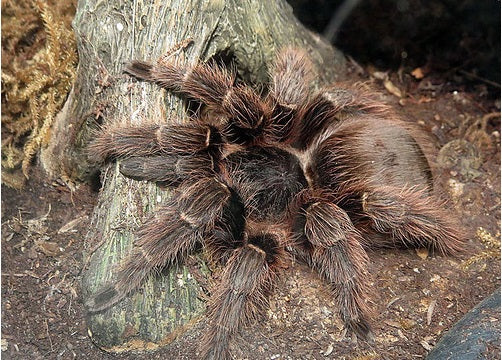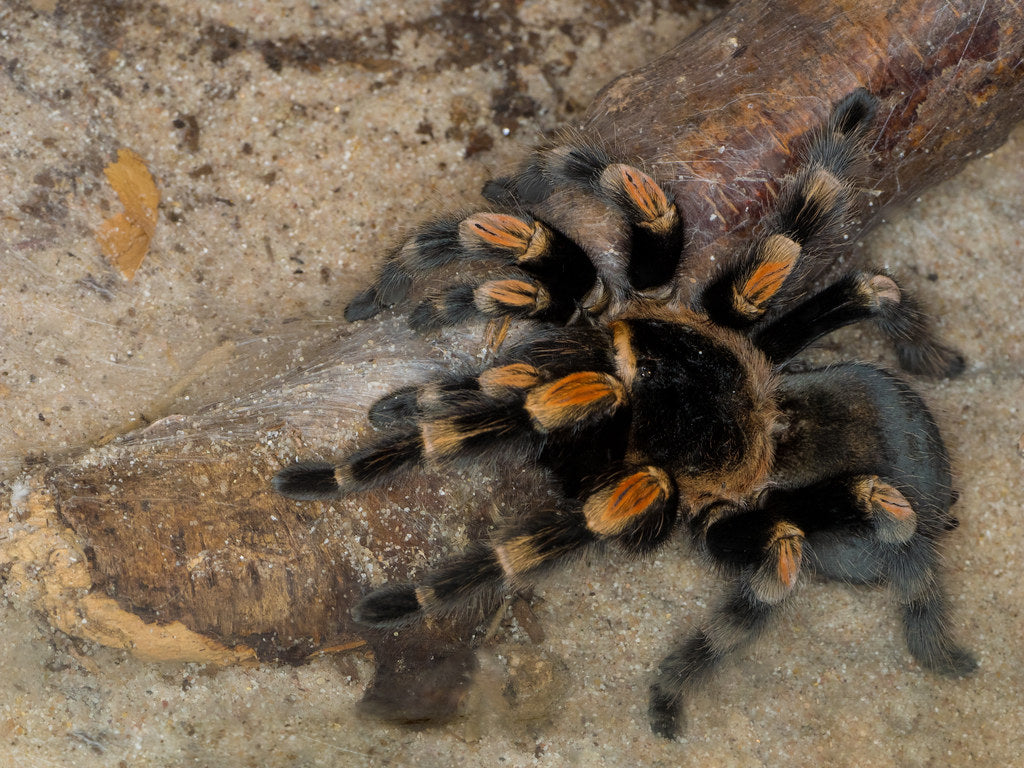Pink Zebra Beauty tarantulas (Eupalaestrus campestratus) are medium-sized, nocturnal, terrestrial tarantulas found in Paraguay, Brazil, and Argentina. Their preferred habitat is tropical and subtropical grassland/savanna.
Pink zebra beauty tarantulas typically have a 5-6” legspan as adults. Their body has a black-brown base color with pale pink hairs and striping on the legs, otherwise having a typical tarantula appearance.
Pink zebra beauty tarantulas are known as some of the best beginner-level tarantulas due to their exceptional hardiness, activity, slow movement, and tolerance toward humans. Males typically live 5-6 years and females may live up to 20 years with good care.
How much space do pink zebra beauty tarantulas need?
Pink zebra beauty tarantulas don’t need much space, but they do need at least some space for moving around. The minimum for appropriately keeping one adult pink zebra beauty tarantula is 20”L x 10”W x 12”H, or the equivalent of a standard 10-gallon tank.
It takes a few years for pink zebra beauty tarantulas to grow from tiny slings to their adult size. It’s best not to house slings in adult-sized enclosures. Instead, basic acrylic spiderling enclosures are usually suitable, no less than four times the spider’s legspan, and no taller than two legspans above the substrate layer.
Whatever type of enclosure you use, make sure to discourage your tarantula from climbing, and take measures to prevent the possibility of escape.
Cohabitation (keeping multiple tarantulas in one enclosure) is not recommended, as cannibalism is possible.
Do pink zebra beauty tarantulas need UVB?
They can certainly survive without it, and UVB is not commonly used among tarantula keepers. That being said, there is some evidence to suggest that tarantulas may benefit from UVB lighting when appropriately provided. This paper speculates that wild tarantulas may get at least part of their vitamin D3 from UVB exposure, and this paper provides evidence of invertebrates being able to synthesize vitamin D3 from UVB.
If you wish to provide UVB to your tarantula, the best UVB bulb to use is likely to be the compact coil Zoo Med Reptisun 5.0, 26w. The bulb should be mounted horizontally in a reflective fixture, and placed on top of a mesh lid with holes large enough to prevent the tarantula’s legs from getting caught, or tall enough that the tarantula can’t reach it. (For this reason, it may be best to refrain from providing UVB lighting until your tarantula is large enough for an adult-sized enclosure.) UVB bulb output decays over time, so make sure to replace your bulb every 6 months.
Lights should be on for 12 hours/day to provide a clear day/night cycle for your tarantula.
What basking temperatures do pink zebra beauty tarantulas need?
Tarantulas are ectotherms, which means that they need to be kept within a specific range of temperatures in order to regulate their metabolism and stay healthy.
The optimal ambient temperature for pink zebra beauty tarantulas is around 78-80°F during the day. If possible, try to maintain your tarantula’s room at this temperature. However, if this is not possible, and the room is cooler than this range, then you’ll need a heat source. A small heat mat, stuck to the side of the enclosure and regulated with a thermostat set to 80-82°F during the day, should be enough to address this problem. Track the temperatures in your enclosure with a digital probe thermometer.
What humidity levels do pink zebra beauty tarantulas need?
Pink zebra beauty tarantulas generally prefer higher humidity conditions around 70% on average, although it’s okay to simulate a drier “drought” period during the winter. You can track ambient humidity levels with a digital probe hygrometer with the probe placed in the middle of the enclosure.
To increase and maintain humidity in your tarantula’s enclosure, moisten the substrate. It shouldn’t be sopping wet or muddy. In an adult enclosure, only moisten the substrate on the cool end of the setup. If your enclosure is having difficulty retaining humidity, place plastic wrap over the majority of the screen lid.
What substrate is good for pink zebra beauty tarantulas?
Pink zebra beauty tarantulas like to burrow and move their substrate around, so it’s a good idea to provide a generous amount of substrate for them to work with. This also helps maintain the higher humidity levels that they prefer. Depth should be at least 3/4 as deep as the tarantula’s legspan. For an adult, that would be about 4”.
We recommend the following substrates for pink zebra beauty tarantulas:
What décor can you use in a pink zebra beauty tarantula terrarium?
Tarantulas may not seem to do much, but it’s still beneficial to give them items in their enclosure that they can explore and use to express natural behaviors. It also makes the enclosure more attractive!
At minimum, your tarantula needs at least one place to hide. However, additional options include:
- logs
- cork flats
- live or artificial plants
- artificial ornaments
What do pink zebra beauty tarantulas eat?
Tarantulas are carnivores, which means that they need whole prey in order to get the nutrition that they need. Offer an appropriately-sized meal once per week.
Tarantulas should receive 2-5 bugs per meal, depending on their body condition and the nutritional density of the insect (ex: one dubia roach is usually worth multiple crickets). Prey insects should be small enough for the tarantula to overpower, which is an especially important consideration for slings — this is usually roughly the same size or smaller than the length of the tarantula’s abdomen. Live, well-gutloaded prey is a requirement.
Offer a variety of different insects if possible to provide varied nutrition:
- Black crickets
- Black soldier fly larvae
- Brown crickets
- Dubia roaches
- Discoid roaches
- Flightless fruit flies (for slings)
- Mealworms
A pinky mouse or house gecko can be offered to adults as an annual treat.
Remove all uneaten prey within 24 hours to prevent the prey from harassing the tarantula.
Water
Tarantulas under 2” across should receive water via routine (light) misting of the enclosure. The enclosure should be allowed to dry between mistings. Tarantulas over 2” may have a shallow water dish for drinking. Change the water daily and scrub the bowl with a reptile-safe disinfectant weekly.
Do pink zebra beauty tarantulas like to be handled?
As a general rule, it’s best not to handle tarantulas. But as far as tarantulas go, pink zebra beautys tolerate occasional handling very well. They rarely bite, shoot hairs, or even offer a defensive posture. Even when they do bite, you are likely to experience only minor discomfort. When allowed to crawl onto your hand of their own volition and handled gently, pink zebra beautys can be an ideal tarantula for a keeper who prefers to be a little more “hands-on” with their pets.
Never handle a tarantula within a week of molting, and always handle it over a soft surface (ex: your bed or couch) so that if it falls, it won’t get injured.
*This care sheet contains only very basic information. Although it’s a good introduction, please do further research with high-quality sources to obtain additional information on caring for this species.
"Eupalaestrus campestratus" by Dick Culbert is licensed under CC BY 2.0



Leave a comment
This site is protected by hCaptcha and the hCaptcha Privacy Policy and Terms of Service apply.